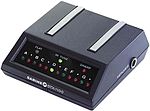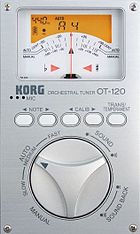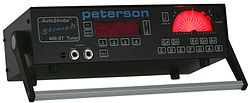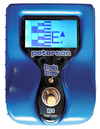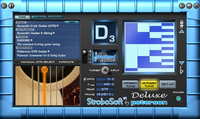- Electronic tuner
-
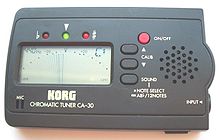 Pocket-sized Korg chromatic LCD tuner, with simulated analog indicator needle
Pocket-sized Korg chromatic LCD tuner, with simulated analog indicator needle
The term electronic tuner can refer to a number of different things, depending which discipline you wish to study.
In the Discipline of radio frequency electronics an electronic tuner is a device which tunes across a part of the radio frequency spectrum by the application of a voltage or appropriate digital code words. This type of tuner supersedes mechanical tuners, which were tuned by manual adjustment of capacitance or inductance in the tuned circuits. In a more practical and everyday sense, a radio or television set which is tuned by manually turning a knob or dial contains a manual tuner into which the shaft of that knob or dial extends. Later model televisions and radios were tuned by a rack of momentary push buttons, some of the earlier types were purely mechanical and adjusted the capacitance or inductance of the tuned circuit to a preset number of positions corresponding to the frequencies of popular local stations. Later electronic types utilized the varactor diode as a voltage controlled capacitance in the tuned circuit to receive a number of preset voltages from the rack of buttons tuning the device instantly to local stations. The mechanical button rack was popular in car radios of the '60s and '70s. The electronic button rack controlling the new electronic varactor tuner was popular in television sets of the '70s and '80s. Modern electronic tuners also use varactor diodes as the actual tuning elements but the voltages which change their capacitance is obtained from a digital to analog converter driven by a microprocessor or phase locked loop arrangement. This modern form allows for very precise tuning and locking-in on weak signals as well as a numerical display of the tuned frequency.
In the Discipline of music an electronic tuner is a device used by musicians to detect and display the pitch of notes played on musical instruments. The simplest tuners use LED lights to indicate approximately whether the pitch of the note played is lower, higher, or approximately equal to the desired pitch. More complex and expensive tuners indicate more precisely the difference between offered note and desired pitch.
Tuners vary in size from units that can fit in a pocket, clip on an instrument, sit on a table-top, all the way up to 19" rack-mount units. The more complex and expensive units are used by instrument technicians, piano tuners and luthiers.[1]
The simplest tuners only detect and display the tuning for a single pitch (often "A" or "E") or for a small number of pitches, such as the six pitches used in the standard tuning of a guitar (E,A,D,G,B,E). More complex tuners offer chromatic tuning, which allows all the 12 notes of the scale to be tuned. Some electronic tuners offer additional features, such as adjustable pitch calibration, different tempered scale options, the sounding of a desired pitch through an amplifier and speaker, and adjustable "read-time" settings which affect how long the tuner takes to measure the pitch of the note.
Considered one of the most accurate tuning devices, strobe tuners, work in a different way to regular electronic tuners; they are basically stroboscopes. These can be used to tune any instrument, including the initial "beating" of steelpan drums, bagpipes, accordions, calliopes, bells, the pins in Music Boxes or any audio device much more accurately than regular LED, LCD or needle display tuners. However, strobe units are generally much more expensive, and the mechanical elements of a mechanical (rather than electronic-display) strobe require periodic servicing. Therefore, these tuners are mainly used by specialists and professional instrument technicians.
Contents
Types
Most tuners contain a microphone and/or an input jack (for electric instruments such as electric guitar), circuitry for detecting the pitch, and some type of display (an analog needle, an LCD simulated image of a needle, LED lights, or a spinning translucent disk illuminated by a strobing backlight). Some tuners have an output, or through-put, so the tuner can be connected 'in-line' from an electric instrument to an amplifier or mixing console. While small tuners are usually battery powered, some tuners also have a jack for an optional AC power supply.
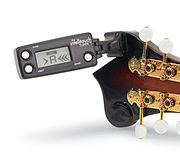 An IntelliTouch clip-on type tuner on a Mandolin headstock.
An IntelliTouch clip-on type tuner on a Mandolin headstock.
The waveform generated by a musical instrument is very complex, as it contains a number of harmonic partials, and it is constantly changing. For this reason the regular tuner must average a number of cycles of the note and use this average to drive its display. Any background noise from other musicians or harmonic overtones from the musical instrument can easily "confuse" the electronic tuner's attempt to "lock" onto the input frequency. This is why the needle or display on regular electronic tuners tends to waver when a pitch is played. Small movements of the needle, or LED, usually represent a tuning error of 1 cent of a semitone. The typical accuracy of these types of tuners is around +/- 3 cents for quality needle tuners and +/- 9 cents of a semitone for the most inexpensive LED tuners. Some companies offer one type of tuner (e.g. Behringer, Quick Time and Fender focus on inexpensive pocket-sized tuners), while other companies, such as Boss and Korg, sell a range of standard, pedal, and rack-mountable tuners at varying levels of quality and features.
"Clip-on" tuners attach with a spring-loaded clip to an instrument (commonly at the headstock of a guitar or scroll of a violin) and pick up vibrations, rather than using a microphone or input jack to sense the input frequency. The tuner then displays the pitch of the instrument's vibration on its large LCD display. Clip-on tuners are less likely to be confused by background noise than a microphone-based tuner, because the clip-on tuners pick up the vibrations of the instrument directly from the body of the instrument. The pioneer of the clip-on tuner industry was the Intellitouch PT1 built by OnBoard Research Corporation.
The "String Master" tuner consists of a regular LED tuner where the electric instrument plugs into the unit's base with a 1/4" TRS cable, or an acoustic instrument via a microphone cable. The unit has a built-in motor which drives a string winder tool at the top to the unit. The unit is then placed over the tuning button of the machine head of the string to be tuned, and a note on the relevant string is played. The unit detects the input note and robotically corrects the pitch to a desired frequency by mechanically turning the tuner button to the correct position. It monitors the change in frequency until the "in tune" signal is given.
Some electric guitar tuners are fitted to the instrument itself, such as the Sabine AX3000 and the "NTune" device. The NTune consists of a switching potentiometer, a wiring harness, illuminated plastic display disc, a circuit board and a battery holder. The unit installs in place of an electric guitar's existing volume knob control. The unit functions as a regular volume knob when not in tuner mode. To operate the tuner, the player pulls the volume knob up. The tuner disconnects the guitar's output so the tuning process is not amplified. The lights on the illuminated ring, under the volume knob, indicate which note is being tuned. When the note is brought into tune a green "in tune" indicator light is illuminated. After tuning is complete the volume knob is pushed back down, disconnecting the tuner from the circuit and re-connecting the pickups to the output jack.
Gibson guitars released a model in 2008 called the "Robot Guitar". It is a customized version of either the Les Paul or SG model. The guitar is fitted with a special tailpiece, looking like a regular unit, with in-built sensors that pick up the frequency of the strings. There is an illuminated control knob with which the player can select different tuning options. The headstock is fitted with custom-built motorized machine heads that automatically tune the guitar. This system can assist the player to intonate the guitar when the unit is put into "intonation" mode, displaying how much adjustment the bridge requires with a system of flashing LEDs on the control knob.
The first automated guitar tuner was invented by JD Richard in 1982 while studying Electrical Engineering at the University of New Brunswick, New Brunswick Canada. This tuner was based on phase-locked-looped feedback design that listened to the frequency of the string and turned a stepper motor (with a 400/1 gear ratio) attached to the tuning peg of the guitar. This first design never went into production although the thesis paper can still be obtained at the university.
Regular needle, LCD and LED display tuners
A needle, LCD or regular LED type tuner uses a microprocessor to measure the average period of the waveform. It uses this to then drive the needle or array of lights. The array of lights from LED that appears to move to left or right seems better than the meter needle of the early meter tuners. When the musician plays a single note, the tuner senses the input from the microphone or input jack (from an electric instrument). The tuner then displays the input frequency in relation to the desired pitch and indicates whether the pitch of that note is lower, higher, or approximately equal to the desired pitch. With needle displays, the note is in tune when the needle is in a 90o vertical position, with leftward or rightward deviations indicating that the note is flat or sharp, respectively. Tuners with a needle are often supplied with a backlight, so that the display can be read on a darkened stage.
For block LED or LCD display tuners, markings on the readout drift left if the note is flat and right if the note is sharp from the desired pitch. If the input frequency is matched to the desired pitch frequency the LEDs are steady in the middle and an 'in tune' reading is given.
Some LCD displays mimic needle tuners with a needle graphic that moves in the same way as a genuine needle tuner. Somewhat misleadingly, many LED displays have a 'strobe mode' that mimics strobe tuners by scrolling the flashing of the LEDs cyclically to simulate the display of a true strobe. However, these are all just display options. The way a regular tuner 'hears' and compares the input note to a desired pitch is exactly the same, with no change in accuracy. For more on how strobe tuners work see the dedicated section.
The least expensive models only detect and display a small number of pitches, often those pitches that are required to tune a given instrument (e.g., E, A, D, G, B, E of standard guitar tuning). While this type of tuner is useful for bands that only use stringed instruments such as guitar and electric bass, it is not that useful for tuning brass or woodwind instruments. Tuners at the next price point offer "chromatic tuning", which means that the device will detect and assess all of the pitches in the chromatic scale (e.g., C, C#, D, D#, etc.). Chromatic tuners can thus be used for Bb and Eb brass instruments such as saxophones and horns.
Many models have circuitry that automatically detects which pitch is being played, and then compares it against the correct pitch. Less expensive models require the musician to specify the target pitch via a switch or slider. Most low- and mid-priced electronic tuners only allow tuning to an equal temperament scale.
Electric guitar and electric bass players who perform concerts may use electronic tuners which are built into an effects pedal often called a "stomp box". These tuners have a rugged metal or heavy-duty plastic housing and a foot-operated switch to toggle between the tuner and a bypass mode. Professional guitarists may use a more expensive version of the LED tuner which is mounted in a rack-mount case, and has a larger range of LEDs, thus allowing a more accurate display of the flatness or sharpness. More expensive models allow the user to select reference pitches other than A440.
In some cases, this is used to select a different note, as in the case of bands which detune their guitars to "Eb" or "D" for a lower, more resonant sound. More subtle changes of a quarter tone or less can be made with some models. This enables instrumentalists to tune to a fixed pitch instrument such as an organ or piano that is not tuned to A440. Some Baroque musicians playing period instruments perform at lower reference pitches such as A435. Some higher-priced electronic tuners allow tuning to a range of different temperaments, which is a feature of interest to some guitarists and to harpsichord players.
Some expensive tuners also include an on-board speaker and amplifier which can sound notes, either to facilitate tuning "by ear" or to act as a pitch reference point for intonation practice, while scales or arpeggios are being practiced. Another feature offered on the most expensive tuners is an adjustable "read time", which determines whether the circuitry will attempt to make a quick assessment of the pitch, or make its assessment over a longer period. Due to their combination of all the above mentioned features, very high-quality needle tuners are suitable for tuning the different types of instruments in an orchestra; these are sometimes called "orchestral tuners".
Strobe tuner
Strobe tuners (the popular term for stroboscopic tuners) are the most accurate type of tuner. There are three types of strobe tuners: The mechanical rotating disk strobe tuner, an LED array strobe in place of the rotating disk, and "virtual strobe" tuners with LCD displays or ones that work on personal computers. A strobe tuner shows the difference between a reference frequency and the musical note. Even the slightest difference between the two will show up as a rotating motion in the strobe display. The accuracy of the tuner is only limited by the internal frequency generator. The strobe tuner detects the pitch either from an TRS input jack or a built-in or external microphone connected to the tuner.
The first strobe tuner dates back to 1936 and was originally made by the Conn company; it was called the Stroboconn and was produced for approximately 40 years. However, these strobes are now mainly collector pieces. They had 12 strobe discs, driven by one motor. The gearing between discs was a very close approximation to the 12th root of two ratio. This tuner had an electrically driven temperature-compensated tuning fork; the electrical output of this fork was amplified to run the motor. The fork had sliding weights, an adjustment knob, and a dial to show the position of the weights. These weights permitted setting it to different reference frequencies (such as A4 = 435 Hz), although over a relatively narrow range, perhaps a whole tone. When set at A4 = 440 Hz the tuning fork produced a 55 Hz signal, which drove the four-pole 1650 RPM synchronous motor to which the A disc was mounted. (The other discs were all gear-driven off of this one.) Incoming audio was amplified to feed a long neon tube common to all 12 discs. Wind instrument repair people liked this tuner because it needed no adjustment to show different notes. Anyone who had to move this tuner around was less inclined to like it because of its size and weight: two record-player-sized cases of 30-40 pounds each.
The best known brand in strobe tuner technology is Peterson Tuners who in 1967 marketed their first strobe tuner, the "Model 400". Other companies, such as Sonic Research and Planet Waves, sell affordable LED-based true strobing tuners. There are other tuners with LEDs that have a 'strobe mode' which simulates the appearance of a strobe. However, the accuracy of these tuners when used in strobe mode is no better than when in any other mode, as it uses the same technique as a needle tuner to measure the frequency of the note, and then it sets the speed of the pattern in the LEDs instead of driving a needle.
How a Strobe tuner works
 The display readout of a mechanical strobe tuner. Each of the eight bands are read for partials within a note. The lowest darkest image represents the fundamental, fainter bands higher on the display represent overtones, or partials. Perceived clockwise movement indicates sharp, counter-clockwise flat.
The display readout of a mechanical strobe tuner. Each of the eight bands are read for partials within a note. The lowest darkest image represents the fundamental, fainter bands higher on the display represent overtones, or partials. Perceived clockwise movement indicates sharp, counter-clockwise flat.
Mechanical strobe tuners have a series of lamps or LEDs powered by amplified audio from the instrument; they flash (or strobe) at the same frequency as the input signal. For instance an 'A' played on a guitar's 6th string at the 5th fret has the frequency of 110 Hz when in tune. An 'A' played on the 1st string at the 5th fret vibrates at 440 Hz. As such, the lamps would flash either 110 or 440 times per second in the above examples. In front of these flashing lights is a motor-driven, translucent printed disc with rings of alternating transparent and opaque sectors.
This disc rotates at a fixed specific speed, set by the user. Each disc rotation speed is set to a particular frequency of the desired note. If the note being played (and making the lamps behind the disc flash) is at exactly the same frequency as the spinning of the disc, then the disc appears to be static (due to an optical illusion) from the strobing effect. If the note is out of tune then the pattern appears to be moving as the light flashing and the disc rotation are out of sync from each other. The more out of tune the played note is, the faster the pattern seems to be moving, although in reality it always spins at the same speed for a given note.
Many good turntables for vinyl disc records have stroboscopic patterns lit by the incoming AC power (mains). The power frequency, either 50 or 60 Hz, serves as the reference, although commercial power frequency is sometimes shifted slightly to meet load demand. The operating principle is the same; although turntable speed is adjusted to stop drifting of the pattern.
 Pattern of a mechanical strobe tuner disc
Pattern of a mechanical strobe tuner disc
As the disc has multiple bands, each with different spacings, each band can be read for different partials within one note. As such, extremely fine tuning can be obtained, because the user can tune to a particular partial within a given note. This is impossible on regular needle, LCD or LED tuners. The strobe system is about 30 times more accurate than a quality electronic tuner, being accurate to 1/10 of a cent. Advertisements for the Sonic Research LED strobe claim that it is accurate to 0.0017 of one semitone or 1/6 of a cent.
Strobe units can often be calibrated for many tunings and preset temperaments and allow for custom temperament programming, stretched tuning, "sweetened" temperament tunings and Buzz Feiten tuning modifications. Due to their accuracy and ability to display partials even on instruments with a very short 'voice', strobe tuners can perform tuning tasks that would be very difficult, if not impossible, for needle-type tuners. For instance, needle/LED display type tuners cannot track the signal to identify a tone of the Caribbean steelpan (often nicknamed the "steeldrum") due to its very short 'voice'. A tuner needs to able to detect the first few partials for tuning such an instrument, which means that only a strobe tuner can be used for steelpan tuning. This is also true of musical pins used in music producing machines like Music Boxes and the like. In such cases a technician has to physically trim off metal from the pin to reach the desired note. The metal pin will only resonate a little when struck. Great accuracy is required as once the metal is trimmed or filed a permanent change in the pin takes place. As such, the strobe-type tuners are the unit of choice for such tasks. Tuners with an accuracy of better than 0.2 cent are required for guitar intonation tuning.
One of the most expensive strobe tuners is the Peterson "Strobe Center", which has twelve separate mechanical strobe displays; one for each note in the chromatic scale. This unit (retailing at about $3,500 US) can tune multiple notes of a sound or chord, displaying each note's overtone sub-structure simultaneously. This gives an overall picture of tuning within a sound, note or chord, which is not possible with any other tuning device. It is often used for tuning complex instruments/sound sources or difficult-to-tune instruments where the technician requires a very accurate and complete aural picture of an instrument's output. For instance, when tuning musical bells, this model will display several of the bell's partials (hum, second partial, tierce, quint and nominal/naming note) as well as the prime, and each of their partials, on separate displays. The unit is heavy and fragile, and it requires a regular maintenance schedule. Each of the twelve displays requires re-calibration over time, dependent on how much it is used. It can be used to teach students about note substructures, which are displayed on the separate strobing displays.
Strobe developments
Mechanical disc strobe tuners are expensive, bulky, delicate, and require periodic maintenance (keeping the motor that spins the disc at the correct speed, replacing the strobing LED backlight, etc.).
For many, a mechanical strobe tuner is simply not practical for one or all of the above reasons. To address these issues, in 2001 Peterson Tuners added a line of non-mechanical electronic strobe tuners that have LCD dot-matrix displays mimicking a mechanical strobe disc display, giving a stroboscopic effect. In 2004 Peterson made a model of LCD strobe in a sturdy floor based "stomp box" for live on-stage use.
Virtual strobe tuners are as accurate as standard mechanical disc strobe tuners. However, there are limitations to the virtual system compared to the disc strobes. The virtual strobes display fewer bands to read note information and it does not pick up harmonic partials like a disc strobe. Rather, each band on a virtual strobe represents octaves of the fundamental being played. On a disc strobe there is "one band correspondence", where each band displays a particular frequency of the note being played. On the virtual strobe system, each band has a few close frequencies combined for ease of reading from an LCD display. This is still accurate for tuning and intonating most instruments, but for instruments where more information on partials is required, like idiophones, there is not a clear separation of the partials.
Sonic Research and Planet Waves both released a true-strobe with a bank of LEDs arranged in a circle that gives a strobing effect based upon the frequency of the input note.
Both LCD and LED display true strobes do not require mechanical servicing and are much cheaper than the mechanical types. As such, they are a popular option for musicians who want the accuracy of a strobe without the high cost and maintenance schedule. However, LED strobe displays offer no information about the harmonic structure of a note, unlike LCD types which do offer four bands of consolidated information.
Peterson released a PC-based virtual strobe tuner in 2008 called "StroboSoft". This computer software package has all the features of a virtual strobe, such as user-programmable temperaments and tunings. To use this tuner, a musician must have a computer in the same location that they wish to tune an instrument. Another alternative is also PC-based strobe tuner TB Strobe Tuner with fewer functions.
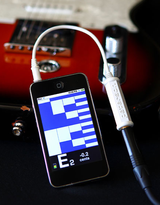 Peterson VirtualStrobe application on iPod Touch
Peterson VirtualStrobe application on iPod Touch
In 2009 Peterson Tuners released a VirtualStrobe tuner as an end-user application add-on for Apple's iPhone and iPod Touch where the application is bought cheaply as a download and installed onto the unit. There's a special 1/4" TRS jack adapter for connecting an electric instrument to the iPhone. This is a very notable achievement in strobe tuner technology, making such tuning widely available to many. However, a compatible iPod or iPhone must already be owned to utilize this application.
As both mechanical and electronic strobes are still much more expensive ($200 to about $3,500 US) than regular tuners (around $10–$100) their use is usually limited to people who tune pianos, harps, and early instruments (e.g., harpsichords) or accurately intonate instruments on a regular basis, such as luthiers, instrument restorers and technicians. These tuners make the intonation process more precise, which is important for the correct set-up of an instrument. Low cost tuners with an accuracy of at least 1 cent do not work well for guitar intonation tuning.
Uses
Classical music
In classical music, there is a longstanding tradition to tune "by ear", by adjusting the pitch of instruments to a reference pitch. In an orchestra, the oboe player gives a 440 Hz "A", and the different instrument sections tune to this note. In chamber music, either one of the woodwind players gives an "A", or if there are no wind players, the first violinist plays their open "A" string. More rarely, the cello player from a string quartet may give the tuning "A". Despite this tradition for tuning by ear, electronic tuners are still widely used in classical music. In orchestras, the oboist who plays the tuning "A" often has a high-end electronic tuner to ensure that his or her "A" is correct. As well, other brass or woodwind players may use electronic tuners to ensure that their instruments are correctly tuned. Classical performers also use tuners off-stage, for practice purposes, either to check their tuning or practice ear training with tuners that sound notes with a speaker.
Electronic tuners are also used in opera orchestras for offstage trumpet effects. In offstage trumpet effects, the trumpet player performs a melody from the backstage or from a hallway behind the stage, creating a haunting, muted effect. Since the trumpet player cannot hear the orchestra, they cannot know if they are in tune with the rest of the ensemble; to resolve this problem, some trumpet players use a high-end, sensitive tuner so that they can monitor the pitch of their notes.
Piano tuners, harp makers, and early instrument restorers and makers (e.g., harpsichords) use high-end tuners to assist with their tuning. Even piano tuners who work mostly "by ear" may use an electronic tuner to tune the first note on the piano, to which they then adjust the other notes. Piano tuners may also use electronic tuners to get a very out-of-tune piano roughly in pitch, after which point they will tune by ear.
Popular and folk music
In popular music, amateur bands from styles as varied as country and heavy metal use electronic tuners to ensure that the guitars and electric bass are correctly tuned.
In loud popular music genres, such as rock, there is a great deal of stage volume, so it would be difficult to tune "by ear". Electronic tuners are helpful aids at jam sessions where a number of players are sharing the stage, because it helps all of the players to have their instruments tuned to the same pitch, even if they have come to the session halfway through. Tuners are helpful with acoustic instruments, because they are more affected by temperature and humidity changes. An acoustic guitar or upright bass that is perfectly in tune backstage will change in pitch under the heat of the stage lights and from the humidity from thousands of dancing audience members.
Tuners are used by guitar technicians who are hired by rock and pop bands to ensure that all of the band's instruments are ready to play at all times. Guitar technicians (often called guitar techs) tune all of the instruments (electric guitars, electric basses, acoustic guitars, mandolins, etc.) before the show, after they are played, and before they are used onstage. Whereas amateur musicians will typically use a relatively inexpensive quartz tuner, guitar technicians typically use expensive, high-end tuners such as strobe tuners. (Most strobe tuners, counter-intuitively, also use quartz crystal oscillators as time references, although the responses are processed differently by the different units.)
See also
References
- ^ Piano Tuners Have Built a Bridge To 18th Century. By KATIE HAFNER. New York Times. February 17, 2000. Article describes the use of electronic tuners by piano and harpsichord tuning technicians, including Mr. Callahan's $800 USD CyberTuner software. Available at: http://query.nytimes.com/gst/fullpage.html?res=9500E4DA1331F934A25751C0A9669C8B63&sec=&spon=&pagewanted=2
External links
Categories:- Consumer electronics
- Musical instrument parts and accessories
Wikimedia Foundation. 2010.

